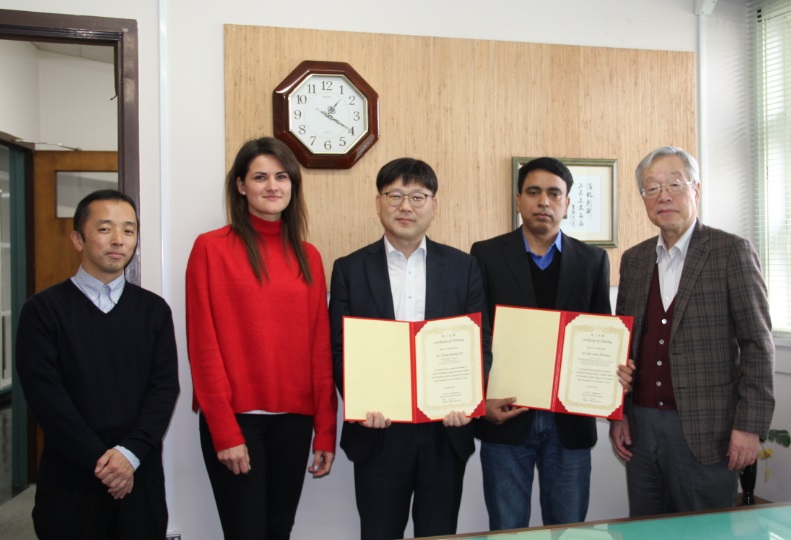- News
A Look at RERF Overseas Trainees: Introduction to RERF’s trainee system
RERF actively recruits trainees interested in learning about RERF’s research. This makes the experience and knowledge gained through our studies of A-bomb survivors widely available for the world’s benefit. Each year about 100 short-term and long-term trainees visit RERF from across the globe.
We hope to encourage scientists and others to apply for a trainee spot. Keep tuned to our website’s ‘What’s New’ section for the latest information on the RERF trainee-recruitment process. The next recruitment period is slated to begin in 2020, around March.
The RERF Department of Molecular Biosciences (MBS) hosted three overseas professionals for participation in a training program November 26–December 6, 2019. Below, we introduce the trainees and their activities.
THE TRAINEES… Dr. Young Kyung Lim, a medical physicist from the National Cancer Center, South Korea, studied with RERF’s Dr. Tomonori Hayashi, Assistant Department Chief, Cell Biology Laboratory, MBS, to learn about damage from radiation, as well as methods for analyzing such damage, including T-cell and chromosomal analyses. Dr. Lim will use the skills gained at RERF to study ultra-high dose-rate effects and proton-minibeam effects in proton-beam cancer therapy in his work back home.
Dr. Ziaur Rahman, a scientist with the Bangladesh Atomic Energy Commission, studied under Drs. Hayashi and Kanya Hamasaki, a researcher in the RERF Cytogenetics Laboratory, MBS. In Bangladesh, Dr. Rahman works in a newly established lab designed for radiation-emergency response, given the country’s burgeoning nuclear-power capability. Dr. Rahman’s goal at RERF was to study biological radiation effects for protecting radiation workers’ health. He learned techniques related to the study of such effects, including blood-collection and culture techniques, cell-harvesting methods, and chromosomal-aberration analyses.
Ms. Laura Komarovska, a researcher at Riga Stradins University’s Institute of Occupational Safety and Environmental Health in Latvia, also worked with Dr. Hayashi. Already in place at RERF is a collaborative relationship with Riga Stradins University; Ms. Komarovska was the latest trainee sent to RERF from there. She learned about DNA extraction, SNP-assay technology, ROS analyses, and Giemsa-staining, as well as biodosimetric studies of A-bomb survivors. Ms. Komarovska’s Institute studies around 5,000 Latvian clean-up workers exposed in the Chernobyl accident, in Ukraine, and 1,600 of their children.
THEIR IMPRESSIONS… Dr. Lim characterized the training program as being beneficial, allowing him to study about the field of molecular biology, about which he knew nothing before, and how that knowledge could be used.
Dr. Rahman repeated how lucky he was to be at RERF, calling the training program beneficial toward helping him “address the health risks of radiation workers from radiation exposure in my country.” However, he suggested that the two-week training be extended to three weeks.
Ms. Komarovska remarked that the training was well organized and used the time available to teach the trainees in an efficient way. She hopes to convey her new knowledge about radiation health effects to colleagues back home to suggest improvements and widen the scope of research being conducted in her laboratory.
LASTLY… From a personal perspective, Ms. Komarovska told us her impressions of Japan and Hiroshima: “Japanese people are quiet and calm and really kind,” she said, adding “okonomiyaki was the best food, with the sauce the best ingredient.”
How does training at RERF sound now? For potential trainees, the above information can be considered when they are trying to decide whether to study with our scientists.

